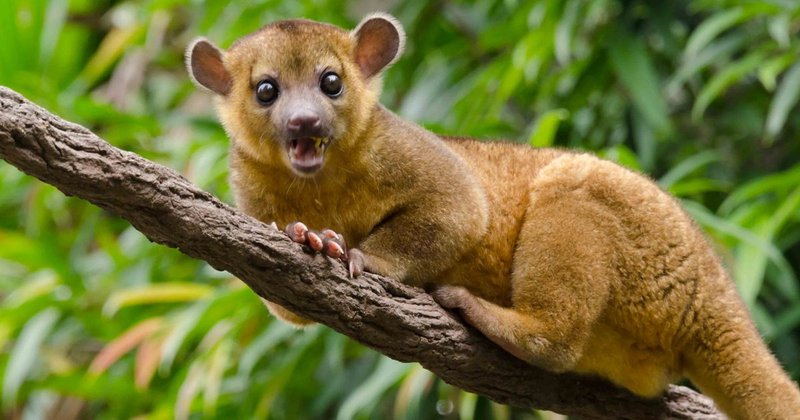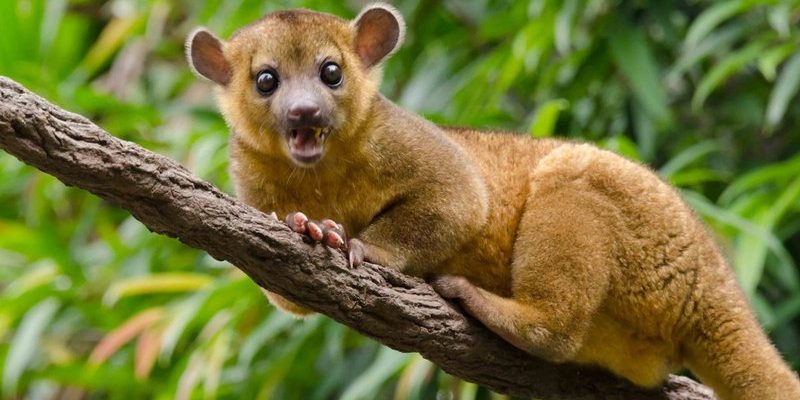
To break it down, kinkajous are nocturnal, tree-dwelling mammals found in Central and South America. With their long tails, big eyes, and soft fur, they often remind people of a cross between a lemur and a teddy bear. But their charm doesn’t stop there. They have some incredible tools in their survival kit, including specialized diets, impressive climbing skills, and even social behaviors. Let’s dive into the various ways kinkajous adapt to their environments, and you’ll quickly see why these little guys are so fascinating.
Diet: A Sweet Tooth in the Jungle
Kinkajous are primarily frugivores, which means they love fruits, especially figs. However, their diet doesn’t end there. They’re known to enjoy nectar, flowers, and even insects. This variety is a big part of how kinkajous survive in tougher environments. You see, when food is scarce, having an adaptable diet allows them to find sustenance in different places.
The kinkajou’s long tongue, which can be up to five inches long, is a perfect tool for reaching deep into flowers to sip nectar. Imagine trying to get the last bit of jelly from a jar—this little guy makes it look easy! By feeding on fruits and nectar, they also play a critical role in their ecosystem as pollinators and seed dispersers. This means they help keep their habitat healthy while also ensuring their own survival.
Adaptations to Climbing: Masters of the Trees
Kinkajous are equipped with some impressive climbing skills. Their strong, grasping hands and feet allow them to climb and navigate through the treetops with ease. This ability is crucial for survival. By living high up in the trees, they can evade ground predators like snakes and big cats, who are less likely to venture into the canopy.
You might be wondering how they manage to balance and maneuver among the branches. Kinkajous have a prehensile tail, which acts like a fifth limb. It helps them maintain stability as they move from branch to branch. Picture a tightrope walker using a pole for balance—this tail gives kinkajous the same kind of assistance. With their natural agility, they can forage for food while staying safe from potential threats.
Nocturnal Lifestyle: The Night Owls of the Jungle
Being nocturnal is another key strategy for kinkajous. While many predators are active during the day, kinkajous have adapted to thrive when the sun goes down. Their large, expressive eyes are specially designed for low-light conditions, allowing them to navigate and hunt for food in the dark.
Imagine wandering around your neighborhood at night with just a flashlight. The kinkajou has an advantage; they can see perfectly in the dim light while avoiding daytime threats. This nocturnal lifestyle means they can spread out their activities—feeding, socializing, and exploring—during hours when it’s safer for them. Plus, their nighttime adventures allow them to tap into food sources that might be less accessible during the day.
Social Behavior: A Supportive Community
Kinkajous are generally social animals, often found living in small family groups. This social structure offers several survival benefits. When they stick together, they can help each other find food and keep watch for predators. Think of it as a group of friends going out together at night, watching each other’s backs while having fun.
They communicate through a range of vocalizations, from barks to whistles, keeping everyone informed about their surroundings. This teamwork is essential, especially in dense jungle environments where it’s easy to get separated. By staying close to each other, kinkajous increase their chances of survival.
Water Sources: Staying Hydrated
Water is a vital resource for any living creature, and kinkajous have adapted well to find it. While they mainly get moisture from fruits and nectar, they aren’t afraid to seek out other water sources when needed. This is crucial during dry spells when food may be lacking.
Sometimes they’ll drink from leaves that collect rainwater or even nibble on succulent plants to quench their thirst. Just like you might search for a cool drink on a hot day, kinkajous know where to go when they need hydration. Being resourceful in finding water makes a huge difference in tough climates.
Sleeping Habits: Finding Safe Havens
Where do kinkajous sleep? They often snuggle up in tree hollows or build cozy nests of leaves and branches. By staying high up, they minimize the risk of encountering predators while they rest. It’s like choosing to sleep on the upper floor of a building rather than the ground level—much safer!
Their sleeping habits also reflect their adaptability. Kinkajous can sleep for long periods, conserving energy during times when food is scarce or when the weather is particularly harsh. This strategic rest helps them recharge so they can be active and foraging when conditions are more favorable.
So there you have it! Kinkajous may seem like cute, cuddly creatures, but they are also incredibly resilient. With their unique diet, climbing abilities, nocturnal habits, social structures, and clever water sourcing, they’ve tailored their survival strategies to thrive in challenging environments.
Just like any other living being, kinkajous face their share of difficulties. However, their adaptability is a testament to nature’s creativity. Understanding how they navigate their harsh world helps us appreciate not just the kinkajous, but the delicate balance of all ecosystems. The next time you hear about these fascinating animals, you’ll know that it’s not just their looks that make them special; it’s their extraordinary survival skills in the wild.

